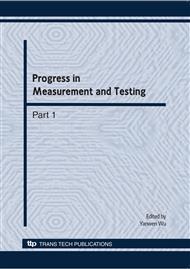p.3
p.11
p.17
p.21
p.27
p.33
p.39
Research on 3D Reconstruction Based on a Single Image
Abstract:
Aimed at the fact that most of the objects was symmetrical, we present a method reconstructing 3D model from single 2D image. At first, the angle, inclination angle and pivot angle should be established in the ternary perspective transformed matrix T, then the calibration which indicated the outline of the object can pick up the characteristic line. It resolved the host extinguishes information in accordance with the similar features of the parallel group of lines projection angle, then ensured the viewpoint situation and the object plane of symmetry, and made use of the object imagination plane of symmetry in accordance with symmetry feature through the interactive alignment specifying three pairs of the known symmetry image coordinates and the space coordinates of the corresponding points confirm the perspective transformative matrix T, then reverse prove the other space coordinates of the surface of the objects.
Info:
Periodical:
Pages:
3-10
Citation:
Online since:
May 2010
Authors:
Price:
Сopyright:
© 2010 Trans Tech Publications Ltd. All Rights Reserved
Share:
Citation:


